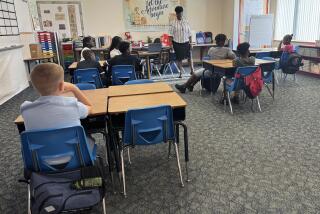Simi School Board to Vote on Reducing Third-Grade Class Sizes
- Share via
SIMI VALLEY — Reopening a shuttered school or bumping sixth-graders from elementary to junior high school could create enough space for the school board to shrink third-grade class sizes starting in February.
Poised to vote at tonight’s meeting on whittling classes to 20 or fewer for third-graders, trustees of the Simi Valley Unified School District will also address the stickier issue of where to put the smaller classes.
The options include bumping sixth-graders into junior high, opening one of four closed elementary schools, buying more than 16 portable classrooms, or adopting year-round classes.
The least costly--and some say most viable--option is moving the district’s 1,400 sixth-graders from elementaries to middle schools next fall, at an estimated cost of about $25,000 to move supplies. Simi Valley’s three junior high schools now have about 50 empty classrooms because ninth-graders were shifted to high school beginning in September.
Although relatively inexpensive, moving sixth-graders from their nurturing neighborhood school to a more distant, depersonalized junior high school will likely be unpopular with parents, said Trustee Debbie Sandland. During her successful bid for school board four years ago, Sandland made her opposition to district reconfiguration a major campaign issue.
“I really don’t think the consensus of the community has changed that much in four years,” Sandland said. “I think parents are happy with sixth-graders at the elementary campuses. . . . I do feel that the sixth-grade age and maturity level is more suited to the elementary school campus. They just need one more year to mature before they go into junior high.”
Spurred by two state incentive programs worth $971 million, trustees in September pared class sizes to 20 or fewer for all the district’s first- and second-graders, but postponed a decision on implementing class size reduction on the third-grade level.
The state programs reimburse school systems $650 for every student enrolled in a class of no more than 20. As it now stands, the state will pay the Simi Valley school district about two-thirds of its $2.9-million price tag for shrinking classes in two grade levels.
Trustees appear inclined to cut class sizes on another grade level. After surveying principals and teachers, a class-size reduction panel has recommended that third-grade, rather than kindergarten, classes be the beneficiary. The additional cost to hire teachers and buy materials would be $547,519, compared with an anticipated state contribution of $903,500, according to Dave Kanthak, assistant superintendent for business services.
The 18,896-student Simi Valley school system would actually make money this year by adding the third-grade level, because the state allotment is the same whether the classes are reduced for a single semester of a full year.
The tricky part about adding third grade to the reduction plan is finding the 16 to 20 additional classrooms needed for the smaller, more plentiful classes, each of which must have its own dedicated room next fall.
Trustees are not expected to make a final decision about the extra classrooms tonight, but Sandland said even discussing the issue seemed premature, because Simi Valley’s long-awaited studies on school boundaries and capacity have not been released.
“Certainly we don’t have all the information to make an informed decision on this issue that might involve a major, major restructuring.”
On the surface, reopening 500-student Arroyo Elementary School, which was closed in 1983 when enrollment dipped, seemed like a more attractive option to Sandland, who believes the $25,000 cost estimate for shifting sixth-graders to junior high is low.
Reopening Arroyo, which is now leased to a Montessori school and day-care center, would cost $1.2 million, including costs of repairs and upgrading, loss of lease income and operating costs.
Another possibility is purchasing at least 16 portable classrooms for a total cost of about $980,000. A less likely option would be to begin year-round schooling, which would run about $100,000 to change pay for more support staff and buy supplies.
Because buying portables or revamping a closed school can take up to seven months, Kanthak said, trustees must decide by the end of January.










